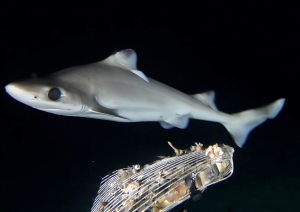 UK-funded deep-sea research publishes initial findings
UK-funded deep-sea research publishes initial findings
3rd July 2023 – A rare gulper shark (pictured) and blurred lantern sharks that glow in the dark have been found in the Cayman Islands’ deep waters for the first time.
The findings come as initial results of The Cayman Islands Department of Environment’s multi-year Deep See Cayman project are published.
Using drop-camera technology and eDNA (environmental DNA) sampling, the research team have been exploring and documenting the habitat and biodiversity of Cayman’s deep sea down to 2,000 m (6,000 ft). Species found in the survey include the rare gulper shark and blurred lantern sharks, which have never before been recorded in the Caribbean. At just 60cm long (approximately two feet), blurred lantern sharks are covered in light-emitting photophores that give this unique family of sharks its name. The research team recorded the shark at over 600 metres deep (around 2,000 feet). Other species of shark found were catsharks and dusky smoothhounds.
The research is being conducted in partnership with Beneath the Waves, Marine Conservation International and Heriot-Watt University, and funded through the UK’s Darwin Plus project with additional support through sales of Whitetip beer from the Cayman Islands Brewery. The Deep See project began in March 2022 and is the first serious effort to explore the islands’ deep seas and previously unexplored areas. The information found as the result of this study will place the Cayman Islands at the forefront in managing deep-sea activities like mining and fishing and enhance the island’s sustainability.
The Cayman Islands is already making inroads in order to protect the archipelago for generations to come. Marine Parks have been long established in Grand Cayman to enhance the protection of coral reefs, allowing rehabilitation of supporting ecosystems, and increased resilience to climate change.
The National Conservation Act which passed in 2013 and is administered via the National Conservation Council, allows the Cayman Islands to protect and conserve endangered, threatened, and endemic plants, wildlife and their habitats through policy informed by the scientific research of the Cayman Islands Department of Environment.
Island visitors keen to explore Cayman’s most pristine ecosystems can stop by the Little Cayman Research Centre in Bloody Bay Marine Park, which belongs to the Central Caribbean Marine Institute dedicated to preserving vibrant oceans and healthy reefs. The Little Cayman Booby Pond and Rookery is managed by the National Trust for the Cayman Islands, and is also a dedicated Ramsar site, as it is home to approximately 7,000 red-footed booby birds; this accounts for at least 30% of the Caribbean’s total population of these beautiful birds and their distinctive red feet.
To discover more about the Cayman Islands, visit: www.visitcaymanislands.com



